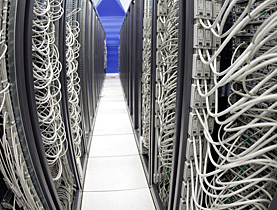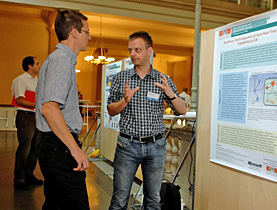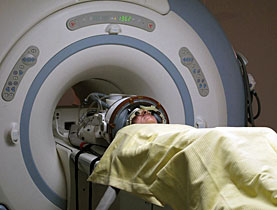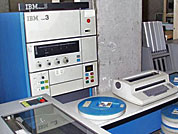Harnessing computer heat can cut energy bills

Companies often spend large sums cooling network servers, but Swiss scientists have found a way to cut those costs by using computer-generated heat to warm buildings.
Physicists at the Federal Institute of Technology in Zurich (ETH) working with IBM have created a liquid-cooled server system that can slash energy bills by as much as half while generating heat with little to no additional carbon emissions.
“Computers are an excellent source of heat that until now has been wasted,” Bruno Michel, an IBM physicist and leader of the project, told swissinfo.ch.
“This is a good chance not only for better efficiency but also for the computer industry to be part of the solution to global warming instead of part of the problem.”
Traditional servers are typically cooled with electrical fans and chillers designed to dissipate high temperatures that can completely destroy expensive hardware.
Such systems are energy hogs and keeping them cool can eat up 80 per cent or more of some firms’ total energy costs. Combined, the world’s information technology industries and data centres consume two per cent of the world’s energy – about the same as global air traffic.
Michel and his team of eight scientists hope to change those figures with a robust server that can do approximately 10.26 trillion calculations a second.
Micro channels filled with water keep the system functioning optimally while collecting heat that can be funneled for use elsewhere. Starting in December, ETH will use a rack of such servers to help heat 60 campus buildings.
“With liquid-cooled cycles you get a much higher possibility of transferring energy from a computer,” said Christian Zeyer, a consultant with E Plus U, a firm that advises firms like swissinfo.ch on energy-saving issues. “This is something that will be very interesting for the future.”
Organic concept
The system should be available commercially soon, but Michel could not offer specifics due to confidentiality agreements.
The liquid-cooled system will likely cost about ten to 30 per cent more than traditional servers but the energy savings would make the system pay for itself after less than two years, he said. It cannot be retrofitted into older systems.
The concept behind the server takes cues from how our own bodies work. The prototype system has a pump that pushes ten litres of water through micro channels that closely resemble capillaries. The pump has about the same efficiency as a human heart.
Computers today convert virtually 100 per cent of the electricity they consume into heat, making them an excellent energy source while crunching data. But temperature of the hardware cannot exceed 85 degrees Celsius without a serious risk of destroying it.
The liquid-cooled system pushes water through the capillaries in hermetically sealed channels that come within a few hundredths of a millimetre of hot components. The water siphons off about five degrees of heat with 85 per cent efficiency. That heat, which pushes the water temperature from 60 to 65 degrees Celsius, can then be pumped into main heating systems.
“The excess heat isn’t enough to warm an entire building on its own,” Michel said. “But for data centres this can help cut costs to cool servers as well as heating costs for energy savings of 50 per cent.”
Rising costs
Liquid-cooled computers themselves are not new but the Zurich team’s approach to coupling the system with a heating unit is unique. In general, liquid-cooled systems have not been practical in the past due to relatively cheap energy costs compared with hardware prices.
That is changing. As energy prices climb and data centres require larger server banks to produce the computing power they need, liquid-cooled servers and their energy savings could become necessary for growing firms.
Michel says that ten years ago the annual energy required to run servers was about five to ten per cent of the hardware costs. In another ten years, it will be closer to 90 per cent.
The business benefits are also environmentally friendly, especially for universities and dense urban areas, like Manhattan, that often have “district” or “neighbourhood” heating networks that link buildings with ducts that distribute heat from one source more efficiently.
Pouring the heat siphoned off servers into those systems can help greatly reduce overall annual carbon-dioxide emissions, which carries perks in the form of tax credits. In one case study, Michel said the savings amounted to €416,000 (SFr630,000) a year or 30 per cent of the energy cost of the entire system.
“We can’t provide heat with no energy,” he said. “But it is possible to do it with no emissions.”
Tim Neville, swissinfo.ch
Christian Zeyer, a consultant with E Plus U, says liquid-cooled computers are just one step toward energy reduction. To maximize savings, a company should also practice “computer virtualization”, which means a server runs at full capacity before other servers kick in. When demand is low, unused machines can remain off.
A second tool is for computers to run at higher temperatures. That allows for a great transfer of energy to the liquid coolant without hurting the computer, he said. That energy can then be directed toward other uses.
19.5 exajoules: Annual heat demand in the EU. Equals roughly the daily energy released by four average hurricanes.
30%-40%: Total of fossil fuels used for heat.
113 million metric tons: CO2 emissions saved annually by heating many buildings with one source. Called district heating.
The liquid-cooled server at ETH allows data centers in all climate zones to be cooled throughout the year without a pre-cooled heat carrier.
To cool the computer, the liquid must first actually be heated with a coil embedded among a rack of servers. A rack is 5.6 cubic metre space filled with individual units. The coil can heat the water to 60 degrees Celsius in a matter of seconds. Once it is warm it shuts off and will not be needed again, as the computer-generate heat will warm the water to 65 degrees.
The coolant then leaves the system, transfers the gained energy to a centralized heating unit for a building, and returns to the computer system at 60 degrees once again.
Other companies are researching innovative ways to keep servers cool. Google is looking at placing data centres on barges and using sea water to keep them cool. Another idea: Place servers underground in old, cool coal mines.

In compliance with the JTI standards
More: SWI swissinfo.ch certified by the Journalism Trust Initiative





You can find an overview of ongoing debates with our journalists here. Please join us!
If you want to start a conversation about a topic raised in this article or want to report factual errors, email us at english@swissinfo.ch.